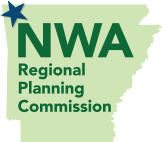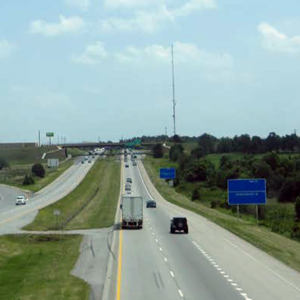Transportation
Forecasting Travel Demand
A travel demand or forecasting model is typically utilized by planners, engineers, MPOs and state departments of transportation to forecast future year transportation system deficiencies that may not exist today. These agencies also use models to evaluate the impact of alternative transportation solutions for development of long range transportation plans. They are primarily used to forecast traffic flows on the transportation system. Models are generally mathematical expressions that are used to replicate the movement of people and vehicles within a transportation system. The traffic forecasts are based on forecasted land use, demographic data, socio-economic factors and travel patterns unique to the region. Travel models are also created to support decision making by providing information about the impacts of alternative transportation and land use policies, as well as demographic and socio-economic trends.
The Northwest Arkansas Travel Demand Model
- In 2004 NWARPC developed the Northwest Arkansas Travel Demand Model for Benton and Washington Counties, AR. The base year for the model was 2005 and scenario runs have been developed for 2010, 2030 and 2035.
- Between the years 2007-2010 NWARPC maintained the model in-house with continuous updates to the network, TAZs, socio-economic data, land use, etc. and used it for projects prioritization, scenarios and the 2035 Regional Transportation Plan and TIP.
- In 2010, conducted a Western Beltway Corridor Study in Benton and Washington County that would connect to the future Hwy. 549 (Bella Vista bypass) in the northern part of Benton County. Part of the Study was to update the existing model to add McDonald County, Missouri to the study area. The model structure and code were also improved as part of the analysis.
- In November 2012, NWARPC started a Transportation Alternatives Analysis Study that was funded by FTA and NWARPC matching funds as part of an Alternatives Analysis grant awarded that year. NWARPC analyzed the need for a major transit investment in the corridor, and to estimate costs, benefits and possible environmental impacts of the various alternatives. As part of the analysis, the consultants used the existing travel demand model to generate ridership estimates in the analyzed corridor.
- In July of 2014, the upgrade of the existing travel forecasting model began which added mode choice to the model for the purpose of modeling vehicular travel as well as transit in the MPA. Under this scope of work NWARPC hired Parsons Brinckerhoff to conduct a travel forecasting model upgrade that addressed all the model needs for a functional true mode choice model. The purpose of the project was to develop the mode choice model to include the transit component; upgrade the model from the 2005 base year to 2010 base year; add the Missouri portion of the MPA into the model; and develop the 2020, 2030 and 2040 forecast years. The upgraded model also incorporated a special generator that is easier to configure and update, reconfigured the GISDK code to current industry standards, and identified ways of utilizing the travel time results from the model to aid the local transit agencies in their route planning,evaluation and needs assessment.
- In 2019 and 2020 the Northwest Arkansas Travel Forecasting Model was improved to update the model to a 2018 base year and forecast years for 2025, 2035 and 2045 and calibrate the transit component to the 2018 completed System-wide origin and destination survey. WSP completed enhancements to the mode choice model work by refining the model calibration and performing additional sensitivity testing. This model enhancement improved the coded transit route system and the transit assignment calibration and validation. The validation and calibration report for the current NWA Travel Demand Model is available at this link.
The model forecast year 2045 includes the fiscally constrained projects list which includes road projects that can reasonably be expected to be funded with federal-aid funds during the 25 year planning period. This is determined by estimates of federal-aid funds that can reasonably be expected to come to the area given the area’s highway network, urbanized area, population, etc. These estimates are provided by ARDOT and MoDOT and are not limits, nor are they guarantees of funding. They are conservative, reasonable estimates of future funding to guide development of the 2045 MTP. The fiscally unconstrained list includes projects not limited to the estimated available funding. An interactive map of the results of the base year and forecast year scenario can be found at this at this link.

